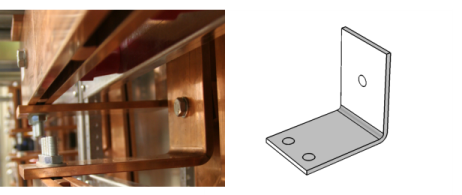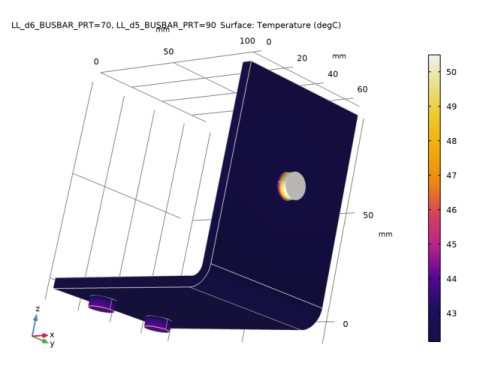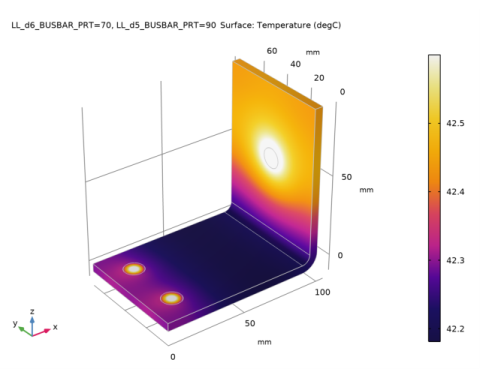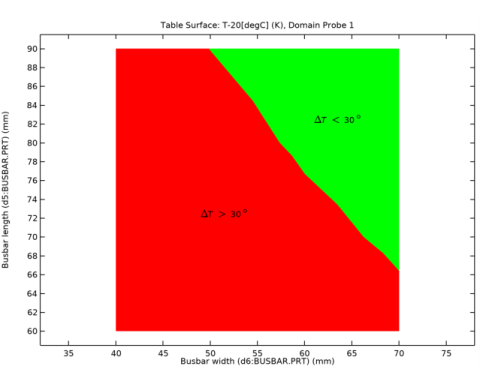
|




|
1
|
In PTC Pro/ENGINEER open the file busbar_assembly_cad/busbar_assembly.asm located in the model’s Application Library folder.
|
|
1
|
|
2
|
|
3
|
Click Add.
|
|
4
|
Click
|
|
5
|
|
6
|
Click
|
|
1
|
|
2
|
|
3
|
|
1
|
|
2
|
|
3
|
Click Synchronize.
|
|
4
|
Click to expand the Parameters in CAD Package section. The table contains the two parameters, d6:BUSBAR.PRT and d5:BUSBAR.PRT, which are part of the PTC Pro/ENGINEER model. In PTC Pro/ENGINEER, the Parameter Selection button on the COMSOL Multiphysics tab allows you to select and view parameters for synchronization. These parameters are retrieved, and appear in the CAD name column of the table. The corresponding entries in the COMSOL name column, LL_d6_BUSBAR_PRT and LL_d5_BUSBAR_PRT, are global parameters in the COMSOL model. These are automatically generated during synchronization, and are assigned the values of the linked PTC Pro/ENGINEER dimensions. The parameter values are displayed in the COMSOL value column.
|
|
5
|
Click to expand the Object Selections section. The selections displayed here are automatically generated based on the assigned materials in the PTC Pro/ENGINEER components.
|
|
6
|
|
1
|
|
2
|
|
3
|
Click
|
|
4
|
|
5
|
Click OK.
|
|
6
|
|
7
|
|
1
|
|
2
|
|
3
|
|
4
|
On the object fin, select Boundaries 8 and 14 only. These are the two bolt faces marked as Ground in Figure 2.
|
|
1
|
|
2
|
In the Settings window for Explicit Selection, type Electric Potential boundary in the Label text field.
|
|
3
|
|
4
|
On the object fin, select Boundary 28 only. This is the bolt surface where the electric potential condition applies, see Figure 2.
|
|
1
|
|
2
|
|
3
|
|
4
|
|
5
|
|
6
|
Click OK.
|
|
7
|
|
8
|
Click
|
|
9
|
In the Add dialog box, in the Selections to subtract list, choose Grounded boundaries and Electric Potential boundary.
|
|
10
|
Click OK.
|
|
1
|
|
2
|
|
3
|
|
4
|
Browse to the model’s Application Libraries folder and double-click the file busbar_parameters.txt.
|
|
1
|
|
2
|
|
3
|
|
4
|
Click Search.
|
|
5
|
In the tree, select Built-in>Copper.
|
|
6
|
|
1
|
|
2
|
|
1
|
|
2
|
|
3
|
Click Search.
|
|
4
|
|
5
|
|
1
|
|
2
|
|
1
|
In the Model Builder window, under Component 1 (comp1) right-click Electric Currents (ec) and choose Ground.
|
|
2
|
|
3
|
|
1
|
|
2
|
|
3
|
|
4
|
|
1
|
|
2
|
|
3
|
|
4
|
|
5
|
|
1
|
|
2
|
|
3
|
Click
|
|
4
|
|
5
|
Click
|
|
6
|
|
7
|
|
8
|
|
9
|
Click Replace.
|
|
10
|
|
11
|
|
12
|
Click
|
|
14
|
|
15
|
Click
|
|
16
|
|
17
|
|
18
|
|
19
|
Click Replace.
|
|
20
|
|
21
|
|
22
|
|
23
|
|
1
|
|
2
|
|
3
|
|
1
|
|
2
|
|
3
|
|
4
|
|
5
|
|
6
|
|
7
|
|
8
|
|
9
|
|
10
|
|
1
|
|
2
|
|
3
|
|
4
|
|
1
|
Go to the Table window.
|
|
2
|
|
1
|
In the Model Builder window, under Results>2D Plot Group 5 right-click Table Surface 1 and choose Duplicate.
|
|
2
|
|
3
|
|
4
|
|
5
|
|
6
|
|
7
|
|
1
|
|
2
|
|
3
|
|
4
|
|
5
|
|
1
|
|
2
|
|
3
|
|
4
|
In the associated text field, type Busbar width (d6:BUSBAR.PRT) (mm).
|
|
5
|
|
6
|
In the associated text field, type Busbar length (d5:BUSBAR.PRT) (mm).
|
|
1
|
|
2
|
|
3
|
|
4
|
|
5
|
|
6
|
|
7
|
|
8
|
|
1
|
|
2
|
|
3
|
|
4
|
|
5
|
|
6
|
|
7
|
|
8
|
|
9
|